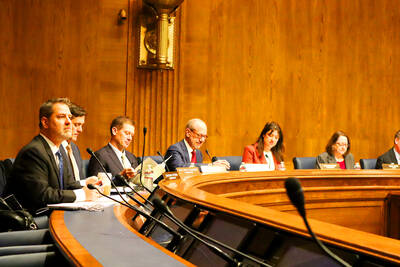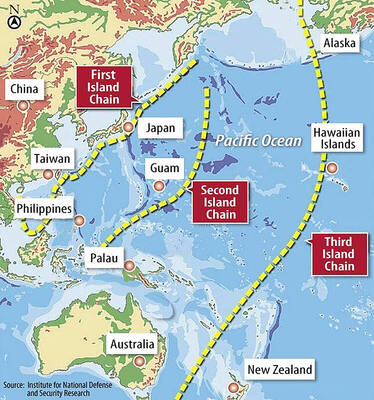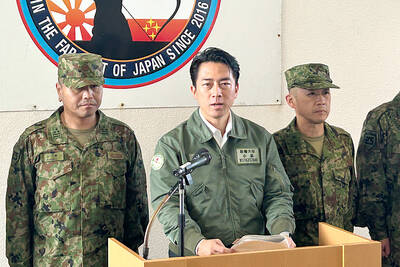China is preparing to arm its stealthiest submarines with nuclear missiles that could reach the US, cloaking its arsenal with the invisibility needed to retaliate in the event of an enemy strike.
Fifty years after China carried out its first nuclear test, patrols by the almost impossible-to-detect Jin-class submarines armed with nuclear JL–2 ballistic missiles will give Chinese President Xi Jinping (習近平) greater agility to respond to an attack.
The nuclear-powered subs will probably conduct initial patrols with the missiles by the end of this year, “giving China its first credible sea-based nuclear deterrent,” according to a report to the US Congress submitted last month by the US-China Economic and Security Review Commission.
Deploying the vessels will burnish China’s prestige as Xi seeks to end what he calls the “cold war” mentality that resulted in US dominance of Asia-Pacific security. Since coming to power, Xi has increased military spending with a focus on longer-range capacity, including plans to add to the country’s tally of a single aircraft carrier.
“For the first time in history, China’s nuclear arsenal will be invulnerable to a first strike,” said independent strategist Nicolas Giacometti, who has written analysis for The Diplomat and the Center for Strategic and International Studies. “It’s the last leap toward China’s assured nuclear-retaliation capability.”
China’s nuclear defense strategy is engineered to provide retaliation capability in the event of attack from nuclear powered nations as far away as the US, and also from Russia and India, according to Felix Chang, a senior fellow at the Foreign Policy Research Institute in Philadelphia.
While China does not view North Korea as a direct nuclear risk, officials are concerned about what might happen if North Korea threatened South Korea, or Japan and the region became unstable, Chang said.
China’s nuclear-armed submarines will be “useful as a hedge to any potential nuclear threats, including those from North Korea, even if they are relatively small,” he said.
The deployment of the submarines could pressure China to assure foreign militaries that its navy chiefs and political leaders can communicate with and control them. Chinese and US ships and planes are coming into greater proximity in the Pacific as China asserts its claims to territory in the South China Sea and East China Sea.
Former US secretary of defense Robert Gates said in an interview in January that former Chinese president Hu Jintao (胡錦濤) “did not have strong control” of the People’s Liberation Army.
The “best example,” Gates said, was China’s rollout of its J-20 stealth fighter jet during a visit he made in January 2010, which seemed to catch Hu unaware.
Since coming to power, Xi has tightened his grip on the military, taking over as head of the Central Military Commission (CMC) in November 2012, when he became Chinese Communist Party secretary-general. Hu waited about two years before becoming chairman of the commission.
“China is going to have to reassure their adversaries that those submarines are under positive control at all times,” said Malcolm Davis, an assistant professor of China-Western relations at Bond University in Australia.
“Positive control” refers to the procedures to ensure the commission’s absolute control of its nuclear assets, such as the authorization codes it would send to submarines, where, after verification by the commander and probably two other officers, missiles would be launched.
“It demands that China set up appropriate command and control infrastructure to ensure that the CMC can keep in touch with the submarines, even when they are at sea and under the water,” Davis said. “The US, UK, France and Russia all maintain such communications capabilities for ensuring positive control” of their submarines at sea.
By assuring potential enemies that weapons will only be fired if ordered by central command, China’s military would increase the deterrent value of its nuclear-armed submarines, he said.
“Those assurances are likely to be made at the highest level military-to-military meetings behind closed doors,” Davis said.
Otherwise China is largely expected to keep its nuclear capabilities secret.
“High-confidence assessments of the numbers of Chinese nuclear capable ballistic missiles and nuclear warheads are not possible due to China’s lack of transparency about its nuclear program,” the US report to Congress said.
The Pentagon has not provided an estimate of the size of China’s nuclear warhead stockpile since 2006, according to the report.
China’s Ministry of National Defense did not reply to faxed questions about when regular patrols by nuclear-armed Jin-class submarines would begin.
The modernization of China’s nuclear forces is focused on improving the capacity to deter other nuclear powers, said Giacometti, speaking by telephone from Brussels.
Until 2006, its only ballistic missile able to deliver a nuclear warhead to the continental US was the liquid-fueled, silo-based DF-5A, he said.
These were considered vulnerable because fueling takes a few hours during which the missile must remain in its silo. To protect them, China built mock silos and adopted a policy of secrecy that made disarming a first strike harder to execute.
In 2006, China introduced the land-based mobile DF-31A ballistic missiles, whose 11,200km maximum range could reach the US.
The missiles are solid-fueled, so can be fired almost immediately if warheads are pre-fitted, Giacometti said.
The US’ intelligence, surveillance and reconnaissance capabilities — from satellites to high-altitude drones, such as the Northrop Grumman RQ-4 Global Hawk — can monitor vast areas of territory and detect mobile intercontinental ballistic missile launchers, he said.
Any information gleaned could be transmitted to US strike assets to take out the launchers before they fire.
In comparison with the land-based launchers, nuclear-powered ballistic-missile submarines that rarely need to surface are much better at hiding. China has three of them — the Jin class — and is likely to add two more by 2020, according to the commission’s report.
Each could carry 12 JL-2 missiles, which after a decade of development “appear to have reached initial operational capability,” it said.
The JL–2’s range of about 7,400km means China could conduct nuclear strikes against Alaska if it unleashed the missiles from waters near China; against Alaska and Hawaii if launched from waters south of Japan; against Alaska, Hawaii and western continental US if fired from waters west of Hawaii; and against all 50 US states if launched from waters east of Hawaii, the report said.
“The big scoop would be determining where those submarine patrols will take place,” Chang said.
The submarines are expected to initially confine themselves to China’s coastal waters and the South China Sea where they could roam with little chance of detection.
For the missiles to reach Hawaii or the continental US, the submarines would need to foray into the western Pacific and beyond, which Davis said would be “more challenging because they’d have to run the gauntlet of US anti-submarine capabilities.”
China’s advances are cause for concern in some parts of the US defense establishment.
“We must continue to modernize our nuclear capabilities,” Admiral Harry Harris said on Tuesday last week at his nomination hearing to become commander of the US Pacific Command, when asked how the US should respond to China’s build up, adding that he considered North Korea to be the biggest threat to security in Asia.
Analysts do not expect China to modify its longstanding “no-first-use” nuclear policy that states its weapons will only be used if China comes under nuclear attack.
Having enhanced its nuclear-deterrence capability, China may begin to communicate more about the planned evolution of its nuclear forces, Giacometti said.
“More openness on China’s side might then open up more space for confidence-building measures and lay the ground for future arms control discussions,” he said.

LIMITS: While China increases military pressure on Taiwan and expands its use of cognitive warfare, it is unwilling to target tech supply chains, the report said US and Taiwan military officials have warned that the Chinese People’s Liberation Army (PLA) could implement a blockade within “a matter of hours” and need only “minimal conversion time” prior to an attack on Taiwan, a report released on Tuesday by the US Senate’s China Economic and Security Review Commission said. “While there is no indication that China is planning an imminent attack, the United States and its allies and partners can no longer assume that a Taiwan contingency is a distant possibility for which they would have ample time to prepare,” it said. The commission made the comments in its annual

DETERMINATION: Beijing’s actions toward Tokyo have drawn international attention, but would likely bolster regional coordination and defense networks, the report said Japanese Prime Minister Sanae Takaichi’s administration is likely to prioritize security reforms and deterrence in the face of recent “hybrid” threats from China, the National Security Bureau (NSB) said. The bureau made the assessment in a written report to the Legislative Yuan ahead of an oral report and questions-and-answers session at the legislature’s Foreign Affairs and National Defense Committee tomorrow. The key points of Japan’s security reforms would be to reinforce security cooperation with the US, including enhancing defense deployment in the first island chain, pushing forward the integrated command and operations of the Japan Self-Defense Forces and US Forces Japan, as

IN THE NATIONAL INTEREST: Deputy Minister of Foreign Affairs Francois Wu said the strengthening of military facilities would help to maintain security in the Taiwan Strait Japanese Minister of Defense Shinjiro Koizumi, visiting a military base close to Taiwan, said plans to deploy missiles to the post would move forward as tensions smolder between Tokyo and Beijing. “The deployment can help lower the chance of an armed attack on our country,” Koizumi told reporters on Sunday as he wrapped up his first trip to the base on the southern Japanese island of Yonaguni. “The view that it will heighten regional tensions is not accurate.” Former Japanese minister of defense Gen Nakatani in January said that Tokyo wanted to base Type 03 Chu-SAM missiles on Yonaguni, but little progress

NO CHANGES: A Japanese spokesperson said that Tokyo remains consistent and open for dialogue, while Beijing has canceled diplomatic engagements A Japanese official blasted China’s claims that Japanese Prime Minister Sanae Takaichi has altered Japan’s position on a Taiwan crisis as “entirely baseless,” calling for more dialogue to stop ties between Asia’s top economies from spiraling. China vowed to take resolute self-defense against Japan if it “dared to intervene militarily in the Taiwan Strait” in a letter delivered Friday to the UN. “I’m aware of this letter,” said Maki Kobayashi, a senior Japanese government spokeswoman. “The claim our country has altered its position is entirely baseless,” she said on the sidelines of the G20 summit in Johannesburg on Saturday. The Chinese Ministry